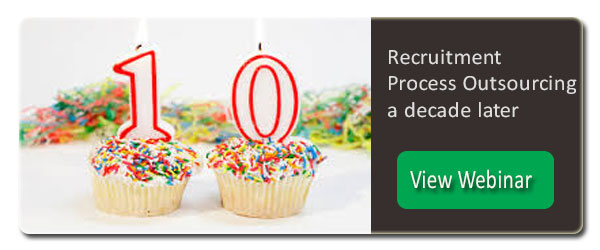 In 2014, the Recruitment Process Outsourcing Association celebrated 10 years of the RPO industry by hosting a webinar, titled Recruitment Process Outsourcing a Decade Later, that highlighted the industry's evolution from infancy, to where it is right now 10 years later, and what we expect will be the future of RPO. We've also been busy working on our mission of "educating the market about RPO" by producing more education webinars and writing more content for our blog, the RPO Post. In case you missed them, here is a compilation of the 2014 top ten RPO news from our RPO Post.
In 2014, the Recruitment Process Outsourcing Association celebrated 10 years of the RPO industry by hosting a webinar, titled Recruitment Process Outsourcing a Decade Later, that highlighted the industry's evolution from infancy, to where it is right now 10 years later, and what we expect will be the future of RPO. We've also been busy working on our mission of "educating the market about RPO" by producing more education webinars and writing more content for our blog, the RPO Post. In case you missed them, here is a compilation of the 2014 top ten RPO news from our RPO Post.
Winning Top Talent with RPO and ATS
The recruitment process is crucial for a company’s long-term success, and the many steps can be difficult to navigate without help. This article explains how HR and in-house recruitment teams can benefit from integrating RPO and ATS into their hiring and onboarding processes. Using ATS to track applicants and mixing and matching RPO with various pieces of the recruitment and onboarding processes gives the HR team the time and freedom to focus on the internal mission and goals of the company.
Understanding What RPO Is and RPO Isn’t
Understanding RPO can be confusing. One provider may offer a service that another does not, and some companies that call themselves RPO providers may not be offering true RPO services. This article takes a look at the definition of recruitment process outsourcing, and how it differs from (and is often confused with) headhunting and human resources outsourcing. Ultimately, RPO is about improving the recruitment process, and the trust, accountability, and commitment required to do so.
How Much Does RPO Cost: Models and Comparisons
A common question for RPO buyers is “How much does it cost?” It’s a fair question, but there isn’t a clean answer, since providers charge differently for different services and goals. This article describes five pricing models used by RPO providers, and various kinds of RPO providers use them. It also compares in-house recruitment costs to RPO costs, and points out that comparing costs is much more than going line-by-line through a budget – intangible benefits can be vast.
3 Characteristics of Compelling Employment Branding
A company’s internal brand is just as important as its external brand. The external brand encourages purchasers to use its products or services; the internal brand (the employment brand) makes employees and potential employees want to work for and stay with the company. This article outlines three important characteristics of compelling employee brands, and why they work to make sure employees see their company the way it wants to be seen.
3 Amazing Tips for Your Mobile Recruitment Strategy
We live in a mobile world; in fact, there’s a good chance you’re reading this on your phone. This article walks you through ways you can benefit from a mobile recruiting strategy with three tips to maximize your presence, draw in candidates, and make it easier for candidates to contact recruiters. An up-to-date mobile recruitment strategy is much more than a smartphone-friendly website. It means blog posts, youtube videos, social media, and an easier and friendlier candidate experience.
Demystifying Applicant Tracking Systems for Recruitment Success
Applicant Tracking Systems (ATS) are one of the most important (and popular!) ways to improve the recruiting process. ATS use is expanding quickly, and for a simple reason – it makes the recruiting process easier. This article walks you through the definition and features of ATS systems, as well as how to compare different ATS systems and the companies that use them. The result? A simple, easy-to-understand introduction to a fabulous technology.
Getting a Hold on Your Metrics
Measuring inputs, outputs and sources are important, but put raw numbers in front of your company’s board and they’ll stare at you blankly. This article addresses how to think about and present your metrics in a way that will get results and attention from the people you show them to. Telling a story, presenting the facts from the listener’s point of view, and relating your information to the bottom line of the company are great ways to get people invested in your work.
3 Points to Remember for a Healthy RPO Relationship
A RPO provider-buyer relationship is like any other relationship – it requires work. A bad relationship will cost time and money, and won’t bring in the results the parties want. This article outlines three items to work towards in RPO relationships and why they are essential for the relationship’s success. Making the relationship a 50/50 partnership is crucial, as is clearly defining responsibilities. Finally, a good fit is worth the wait. Make sure the buyer needs and provider services match up before beginning any RPO relationship.
Suggestions to Help Guarantee RPO Success
For RPO, success means a good hire. Lots of time and resources go into this result, but the hire is the bottom line. There are steps buyers can take (often before the ink on the agreement is dry) to ensure success in an RPO relationship, and this article delves into two of them. Learning about the implementation process the provider uses and starting with a test project are good ways to make sure you get the result you’re looking for.
How Culture Makes or Breaks the Recruiting Process
Company culture is often the core of brilliant success or withering failure. We prefer the former, so this article includes summaries and links to five other articles that show you how to embrace and promote your company culture, motivate employees, and improve your hiring process. Employees and potential employees are the foundation of a company, and a culture and process that makes them feel valued is worth its weight in gold.








.jpg)






